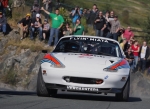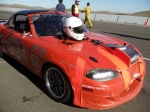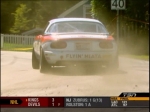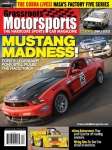| MIATA BUILD |
|
|
 |  |  | September 30, 2011 - Overall, the car is in excellent shape.
The rear subframe brace took the worst beating, which wasn't a surprise. Ground clearance back there is at a bit of a premium and my experience in 2008 was that the back was the most likely place to hit. The skid plate/brace did exactly what it was supposed to do and protected the important bits.
Elsewhere, there's very little sign that the car just finished such an ordeal. In fact, all we need to do is bang the rear skid plate into shape and we could run another week. Even the tires would be good for a few more days of racing. We replaced a coil that had heatsoak problems due to my heat shielding, had a video camera die (and lost a GoPro off the roof at speed) and of course lost the main relay. But overall, the car proved itself to be a strong and reliable tool with a huge turn of speed. By contrast, I was speaking to one of the MINI drivers after the event and he had a big list of problems to fix. For example, both of his front upper strut mounts were damaged and he'd replaced them once or twice already during the race. We had no similar concerns.
I've also been thinking about The Relay. At the time it happened, I felt that I should have been able to fix it on the side of the road and rejoin the race without the DNF for one stage. However, it wouldn't have made any difference in the end. By the time we'd extricated ourselves from the car, set up the triangles and OK sign, instantly diagnosed the problem, reloaded ourselves and rejoined the stage, we would have lost too much time to catch the Challenger and the M3 that finished ahead of us.
entry 1006 - tags: impact protection, skid plate, post-race |  |  |  | October 6, 2011 - Transit in the rain.
Heading from the final stage to the finish line in a light drizzle, photo by Zach Bowman who was quite entertaining as he hung out of the window of the other Miata.
entry 1007 - tags: 2011 race, day 5 |  |  |  | October 10, 2011 - Time for a post-event track day.
Why? Because I can! The car was in as-raced form, right down to the bag of snacks stuffed into the passenger's door. I'd never actually tested this swaybar setup on our track, and I'd made some tweaks to the shocks in Newfoundland. So I figured this would be an interesting check on how the race setup worked in the different environment.
The weather was quite a bit different than my previous test days at this track. Instead of the very hot temperatures that plagued the testing all summer, it was cool. About the same temperatures as seen during the race, actually.
My first session was very entertaining. The car was loose, very loose. I know it had some oversteer tendencies during the race but that was also coupled with great turn-in and lots of adjustability, so I was quite happy with that. Rally drivers hate understeer! But on the little tight track, it was too much. The rear sway was on the middle setting, so I tried disconnecting it completely. That led to too much understeer on turn-in. Setting the sway to the softest setting woke the car up again. It was still a bit tail-happy, but very controllable. I think the best setup would be a slightly smaller rear sway bar than I currently have, so I'll dig into my collection. On a bigger, faster track the current setup would probably work very well.
So how did it work out? I set a personal best in the car, a 1:03.661. My previous best time was 1:03.725. Not a big improvement - but it's significant because the previous time was set on the RA1 tires and with much stiffer and lower suspension settings. I'm thinking I'll pick up a set of R-compound tires for next summer while I continue to run the R1R on the street. That should make a considerable improvement.
I did have one failure on the day, though. When I was driving down the interstate to the track, one of the exhaust tips fell off. Not a major failure, and I didn't even notice until I saw the car in the pits. oops!
The picture has nothing to do with the track day, but I didn't have my camera with me. Taken by Zach Bowman.
entry 1008 - tags: testing, track |  |  |  | October 24, 2011 - Road test!
If you're wondering what it's like to drive the Targa Miata, Zach Bowman can tell you. He slipped behind the wheel after the race and got a chance to get a feel for the car. I wish I'd been able to get him on to a closed stage so he could really feel it rampage, but he was really impressed with what he got. His biggest surprise was how docile the car was. He was expecting a challenging car, but the Targa Miata is really a pussycat to drive fast.
If you want to read Zach's writeup, it's on Autoblog.
The picture is of the Torbay prologue stage, taken by Ralph Saulnier. Come to think of it, it might have been fun to strap Zach into the passenger's seat for the second time through this stage.
entry 1009 - tags: autoblog, test drive, review, press |  |  |  | October 31, 2011 - I won't have to tape the front of the hood down anymore.
Another pair of hood pins at the front of the hood means no more lifting bodywork at speed. There are a lot of hood pins on this car now - four on the front and four on the back.
I also spent some time fixing the passenger's side rear view mirror. Big jobs? No. But improvements. And that's always good.
entry 1010 - tags: body |  |  |  | December 5, 2011 - I spent the weekend working for the 949Racing race team at the 25 hours of Thunderhill.
The two team cars finished 1st and 3rd in class, won the under 2.0 liter trophy and came in 8th and 11th overall. An excellent result, due to good cars, great driving and some very hard work by every member of the service crew - particularly when both cars had problems at the same time at around 1 am. And yes, that's what one car looked like at the end of the race.
It's really interesting to see what's involved in a successful endurance team. It's not just about going quickly, although that's obviously important. You have to watch your fuel use, because every moment you're not circulating the track your competitors are getting away. The cars have to be monitored as much as possible so that any failing components can be replaced quickly and before they become a major problem. Even something as simple as taking 20 seconds to check the oil every time you fill up can add 5 minutes of time in the pits over the course of the race. We practiced fuel stops, tire changes and driver changes with a stopwatch, trying to find a way to shave off 5 seconds each time. You could really see a difference in the pits between teams.
For example, on a four tire change, we had five guys. When the car stopped, two started lifting up the car with a jack on each side while a third lifted from the back. Two others pulled the rear lug nuts off with an impact gun. When the nuts were off, they'd move to a front wheel and start on those lugs. As soon as the car was up, the side jack guys went to the rear wheels, pulled off the old wheel and slotted a new one on to the lugs. Once the front nuts were off, the impact guns were tossed over to the guys at the rear wheels to tighten them on. When that was done, the front wheels had been changed and the guns went back to the front to tighten those up. The side jack men were back on the jacks by this point and the car was dropped to the ground. During all of this, the rear jack operator was placing wheels within reach and catching hot ones. Total time, less than a minute and every person and tool was busy the entire time.
And, of course, there are always repairs done while the clock ticks away. We had a car run off the track after brake use spiked up and the pads wore down to the backing plates - that left us with not only body damage, but also a damaged caliper. Another lost a wheel due to stud failure. Several hubs went out, along with an alternator. The team was ready for all of these with spare parts, but they still cost time and the repairs had to be done on a smoking hot car in the dark on a moment's notice. We had an excellent service crew and all of this was sorted out far more quickly than you'd expect with very little wasted effort. Quite a rush.
It's interesting to contrast the demands of endurance racing with something like the Targa. The latter's often called "the ironman of motorsports" because of the level of abuse the cars get. The total distance the vehicles cover is actually pretty similar in this case. But the track cars are at full race pace the entire time, with the clock running non-stop. Targa cars have long road sections in between timed stages, and there's always some down time during the day when the car can get checked over.
However, on the track the pits are never more than a couple of minutes away. Even with a wheel missing or running on a badly abused battery, our cars always made it back home - and if the car gets disabled on-track, it's towed in as soon as possible. On the Targa, the service crew could be a long way away and the cars might have to travel quite a distance for repairs. So you may have to perform a field repair with what's carried in the car. It's less a matter of getting it done in seconds and more a matter of doing what needs to be done to get to service.
The damage is different as well. On the track, things either wear out due to stress or (less often) get damaged when the cars make contact. If there are bad bumps on the track, the drivers know about them and will usually avoid or minimize them to protect the car. On the rally, damage is more likely to be related to impacts and pounding. Off-track excursions are usually much more serious due to the lack of runoff areas, and there are surprises lurking in the road that can punish everything underneath.
Some things are the same. Tires need to be managed, either because there's a limited number available or because it takes a valuable minute to change to fresh ones. You still have to trade off speed vs caution, whether it's preserving the car or taking fewer risks. The speech given by the crew chief before the 25 hour race started sounded much like my speech to the Targa crew, stressing the importance of getting the car home.
They're both long, tiring and very challenging types of racing. I'm glad I was given the opportunity to take part in the 25 Hour race with such a good team!
entry 1011 - tags: 25 hours of Thunderhill, endurance racing |  |  |  | January 21, 2012 - Time to get the car ready for a different sort of use.
It's going to be seeing the track a fair bit in the next year, and that means a different setup than the rally one.
The R1Rs were good for the Targa, but they get overwhelmed on the track. So I went back to my old favorites, the RA1 in the same 225/45-15 size. Honestly, I would have put on some Nitto NT-01s if they were available, but they are not. Still, the RA1 is a good choice because they're just so consistent and long lived. I'll be running this set of tires for some time.
The springs will get changed, probably to the 750/450 set I ran for a while previously. It's a fair bit of spring, but the AFCOs make them work and it'll keep the car planted on track. It'll tame the rear end a bit, as I don't want quite such a mobile tail as I had during the rally. I'll drop the ride height as well. I'm thinking of dialing in a bit more front camber than I had before. We'll see.
I'll be at the Miatas at Mazda Raceway Laguna Seca event again at the end of March, so that will be the first "big track" event for the car with a healthy engine. I might see if I can sneak over to High Plains Raceway for a test day before then, but that's a challenge with Colorado winter weather. Still, it's time to get the car out of the garage and tearing up the pavement again!
entry 1012 - tags: testing, tires, track, suspension |  |  |  | January 24, 2012 - Targa 2011 videos are online!
Not every stage - yet - but there are 19 videos from the race uploaded to the Targamiata.com video page as well as the Targa Miata YouTube channel. Bumpercam, roofcam, crewcam and even the classic in-car shot. The patch from Janel's intercom means excellent audio in most of the in-car clips, so you can really hear what she's saying as well as the hollering of the big engine. More videos are gradually being added when I have a spare minute here and there.
The DVD project is well underway. Adam is working on it, and has plans to make one final trip to meet up with Janel, Brandon and myself to do some followup interviews. I'm really looking forward to the final result.
entry 1013 - tags: video, 2011, race |  |  |  | February 15, 2012 - Maintenance time for the Targa car.
I'm changing it over to track spec, and pulled the rotors off for a peek. And what I saw looked very familiar. The pad wear is even on both sides, it's just that the inner face of both front rotors is heavily worn. Interesting. I'm guessing it's related to heat, as the inner face has a dust shield on it while the outer does not. I'm going to do a bit of research here. I do know that the Performance Friction PFC 97 pads can be rough on rotors when cold, but I would expect that to affect both sides.
A new set of rotors is going on, of course. The pads are about 40% worn by eyeball measuring, which isn't bad considering how much I used the brakes this time. Faster car with worse tires means more braking.
entry 1014 - tags: brakes |  |  |  | February 15, 2012 - Time for an oil change.
Yes, that's 7 quarts of Redline oil you're looking at. And it's quite an adventure getting all the oil lines emptied out.
entry 1015 - tags: maintenance |  |  |  | February 20, 2012 - Fun with springs.
The new 750 lb front springs are stiff enough that they don't compress much under the weight of the car, so that means they go loose at full droop. So I decided to start playing with secondary springs again. I've done this in the past, but I had new parts and new info.
The secondary springs available through AFCO start at 300 lbs. A couple of years back, I tried this very setup but found that it was tricky to set the damping and there was too much initial roll. After talking to AFCO, I discovered that they had an extra part that would have helped: a stop that takes the secondary spring out of play after a certain point.
Here's how it works: when both springs are active, you get a lower overall spring rate until the softer secondary binds up. So you adjust the stops so that the spacer between the primary and secondary spring can't move any lower when the car is at rest. So when you're moving in compression, only the big main spring is active. Once the wheel starts to drop below the normal ride height (or wherever else you set that stop) both springs come in to play. Clever.
But also designed for cars with much different suspension than a Miata. With my stiff 6" primaries and 4" secondary springs, I simply couldn't get enough adjustment to drop the car down below rally heights. I might have been in luck with tubular front upper control arms, but I don't have any of those.
So I moved on to a more traditional secondary spring. For a lot of coilovers, that means a super-soft spring of 5-10 lb rate that is fully bound at standard ride height. That keeps the main spring from rattling around at full droop, but it's not strong enough to help extend the suspension when you're actually driving the car - especially if your rebound damping is set for a 750 lb primary. I wanted something closer to 100 lb.
Luckily, I had a set of those on hand - the purple springs in the picture. They were very slightly too small in diameter to fit over the perches on the AFCOs, but a bit of noisy die grinder time took care of that. Voila, 100 lb secondary springs that are in bind at rest.
In the rear, I'm running 550 lb springs without secondaries. I may add some later, we'll see what needs to be done for ride height. 750/550 is more rear spring bias than we usually run on Miatas, but it's actually about the same as I ran during the race. I'll also run with very little (or no) rear sway bar so I maximize my drive off the corners and this spring rate will cut down the understeer. Turn-in understeer will be managed by compression damping, I had it too high during the race.
Fun stuff! Although I am getting a bit sick of pulling the front shocks out.
entry 1016 - tags: suspension |  |  |  | February 24, 2012 - Change in plans.
The 550 lb springs I had on hand were 8" long. Well, that meant a very high minimum rear ride height. Too high for my current purposes. So I swapped them out for some slightly more compliant and shorter 450 lb springs that were in the garage. I'll see how the rate feels and possibly order in some 550s if I prefer those. One nice thing about the softer rear is it means I have a bit more latitude for tuning the balance via sway bar. I don't have secondaries on the rears, although I might add some later.
With all the spring tomfoolery done, the car's back on the ground. It's low compared to the Targa stance! Right about 2" lower. Definitely not ready for Newfoundland.
entry 1017 - tags: suspension, springs |  |  |  | February 26, 2012 - There's a two-page article about the Targa Miata in the March 2012 issue of Banzai magazine.
It's basically the whole story of the car, from the initial build to the finish of the 2011 race as well as the 2011 fundraising. That's a lot to cover in two pages, but luckily the British use larger paper than in the US!
It might be a bit hard to find in North America, I'm not sure how well the magazine is distributed on this side of the pond. But it's worth a look.
entry 1018 - tags: magazine |  |  |  | March 2, 2012 - The air dates for the Targa TV show have been posted!
This is for the official event show, not the special project involving the FM team - there's exciting news to come on that front shortly. Still, it's an hour of hot Targa action so you know it's going to be fun.
These times are for the Canadian TSN and TSN2 channels. It will be shown on SPEED around the world, but the dates for those have not yet been released.
In case you're wondering, that's a screenshot from the 2008 show, taking the rally line around the Brigus hairpin...
TSN
March 22, 2012
12:00 am EST / 1:30 am NST
March 23, 2012
1:00 pm EST / 2:30 pm NST
TSN2
March 10, 2012
10:30 am EST / 12:00 pm NST
March 11, 2012
1:00 am EST / 2:30 am NST
March 12, 2012
3:00 pm EST / 4:30 pm NST
April 5, 2012
7:30 pm EST / 9:00 pm NST
entry 1019 - tags: tv, media |  |  |  | March 2, 2012 - Dyno time!
Before the Targa, our dyno was down for an extended period so all of my tuning was done on the road. And in a car with this sort of power/weight ratio, that's pretty difficult to do. It doesn't spend much time in a particular rev range before leaping on to the next. The car was running really rich which is safer than running lean, but definitely not ideal. So this visit was overdue.
My goal wasn't to determine the maximum power, it was to get the fuel delivery calibrated a bit more intelligently. So I set the dyno up to hold the car at a given RPM. By working the throttle, I could then move the car through all of the load ranges at that engine RPM with lots of time to let the computer zero in on a good mixture. Then I moved on to the next RPM band 400 rpm higher, and do it again. From 2800 to 6000 rpm, it was a long and noisy procedure. By the end, however, I had a tuning map that was a pretty big step up from the hacked-up one I'd started with.
Heat was a bit of a problem. Obviously, holding an engine at 5000 rpm at full throttle against its will does make a bit of heat. The coolant and intake temps would rise over the course of one of my runs, making the numbers a bit less accurate. But still, it helped.
Of course, I did a power run at the end, just to find out. With a very hot engine, the car pulled over 350 hp at the wheels. Not quite the 400 we'd been quoted for the engine, but still pretty darn healthy. There might be a bit more in it when tuned by someone with more experience with these engines.
Thanks to the inopportune arrival of a bunch of snow, I haven't had the chance to feel what it's like on the road. With the leaner mixture, it should have better throttle response. I'm really looking forward to getting the car back down to sea level again.
entry 1020 - tags: dyno, tuning |  |  |  | March 2, 2012 - I mentioned there was some heat involved.
This is what the hot exhaust did to a piece of stovepipe being used to extract the exhaust. In fact, the pipe blew some of the exhaust back out again and melted the bumper - despite having a big suction fan on the other end.
entry 1021 - tags: heat, dyno, testing |  |  |  | March 2, 2012 - With the car off the dyno, I took advantage of the fact that I was at the FM shop to hijack a lift.
Step one was to clean up the front aerodynamics a bit. Previously, there was nothing between the air dam and the skid plate. I did have ducting around the radiator so that air was well used, but otherwise it was just plain messy from an airflow point of view. Not anymore!
The plate can easily be removed if I need to get in there - it's held in with a few machine screws around the bottom of the air dam and four bolts at the back. You can just see some rivets in this picture for one of three stiffening ribs that keep it from flexing, and I also did a bit of work at that corner by the wheel to add a lip for more strength. Since it's made of thin aluminum, it weighs very little. But it should do a lot to clean up the airflow.
One downside is that the airdam is no longer flexible - and the car is also much lower than it was at the Targa. So it's going to be more prone to damage. I'll have to behave myself over drops from now on.
entry 1022 - tags: aero, air dam |  |  |  | March 2, 2012 - I'm also looking at adding a splitter up front.
Made of 0.090" aluminum, I'll probably make it adjustable so I can fine-tune the amount of front downforce on the car at speed. The green tape shows the approximate outline.
I've been doing a lot of aero reading and picking of various people's brains. Jeff at Slick Auto (who donated the carbon fiber headlight lids to the car) has been particularly helpful. His suggestion was for a full belly pan to smooth out the airflow under the car from axle to axle. I'm not sure I can pull that off due to my exhaust, but I'm going to spend some time looking and thinking. The front undertray was really the low hanging fruit. I've got some ideas that will be fun to play with, too.
entry 1023 - tags: aero, splitter, air dam |  |  |  | March 2, 2012 - The Grassroots Motorsports article about our 2011 race is now available online.
While you can no longer get a copy of the February 2012 issue on newsstands, you can probably buy a back issue from GRM directly. And, of course, they're happy to send you a free trial issue.
Read the article - 4 MB PDF. Thanks to GRM for providing the digital copy!
entry 1024 - tags: media |  |  |  | March 8, 2012 - Hopefully the front splitter will see some high loads - that means it's working.
So I gave it a bit of support with these turnbuckles from Longacre. The splitter is fairly solid without them, but since it's bolted to a flexible airdam and a fairly thin undertray it could be better. And now it is.
entry 1025 - tags: aero, splitter |  |  |
|

 THE DIARY
THE DIARY